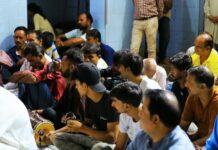Vidya Sethuraman
India Post News Service
CALIFORNIA: Imperial County has the highest COVID-19 infection rate in California – six times higher than the state average – and the caseload is rising, ICU units are 98% full. One fourth of residents live in poverty, 85% are Latino.
The county is a microcosm of the racial and economic disparities that fuel the surge. EMS arranged for a teleconference to discuss this COVID hotspot. Imperial County, population 181,000, is experiencing California’s worst outbreak, according to several public health metrics. Over the last 14 days, the county’s infection rate was more than 588 per 100,000 people – by far the highest in the state. As of Friday (10 July), the county had recorded 7,759 coronavirus cases and 132 fatalities. About 17 patients are airlifted out of Imperial County every day, as the virus takes a devastating toll on Latino residents.
Tung Nguyen, UCSF Health Division of General, Internal Medicine updated the latest COVID status. As of July 12, more than 3,315,300 people in the United States have been infected with the coronavirus and at least 134,900 have died.
Daily coronavirus case counts have been surging to near record highs over the past weeks, and now a new study has found that transmission rates for the virus are also on the rise. In the last 3 weeks, the numbers have increased by 50% in the US. Case numbers are surging throughout much of the United States, including in several states that were among the first to reopen. ICU beds are filling up fast in Texas, Florida, Ohio, Georgia, Louisiana, Nevada, Arizona, Kentucky, West Virginia, and Alabama. Increasing death rates in Texas, Arizona and South Carolina, have all seen their death tolls rise by more than 100 percent in the past four weeks.
The WHO has acknowledged there is emerging evidence that the coronavirus can be spread by tiny particles suspended in the air. The airborne transmission could not be ruled out in crowded, closed or poorly ventilated settings, he said. Masks are effective and it greatly reduces the transmission.
Prof. Edward Flores, Assistant Professor of Sociology, University of California, Merced, shared data that sheds light on the high rate of infection. As of July 8, 2020, eighteen California Counties were on the state’s “watchlist” with a testing positivity rate greater than eight percent.
Many are rural and suburban areas, said Prof Flores. Strikingly, twelve of the fifteen counties characterized by high worker distress had COVID‐19 positive testing rates above eight percent. In contrast, only four of thirty‐ nine counties marked by low worker distress had COVID‐19 positivity above eight percent. We also found a relationship between worker distress and COVID‐19 positivity that remains consistent across geographies. Some of our recommendations include reporting of COVID‐19 positivity by industry, Improved workplace health and safety standards and a greater safety net for workers in essential jobs.
Luis Olmedo, Executive Director, Comité Cívico del Valle Inc. spoke about how Imperial County became the “ideal breeding ground” for the pandemic and the need for structural reforms. With a population of just under 180,000, Imperial County is facing the highest death rate in the state. The striking numbers do not surprise some who know this rural, majority Latino community. The virus is merely exposing the underlying problems.
“We are the poster [child] of those inequities and the reason why we’re not able to control Covid. We cannot win a war on COVID in the emergency room, look at the big picture. We need to fight the war on COVID where it’s breeding and that’s our neighborhoods,” explained Luis Olmedo. In efforts to address COVID-19, Olmedo called for funding non-profit agencies in the County to help coordinate not just a top-down state-led effort but local grassroots efforts as well in order to fight the virus on two fronts. We have to get more medical staff and can’t keep sending our residents to other areas for treatment. He urged the federal and state agencies to step up their work in the local communities.
Luis Flores, activist with the Imperial Valley Equity and Justice Coalition, spoke on how the community fought back the pressure to reopen quickly to protect the most vulnerable. Luis Flores and his friends started a petition on June 3 to oppose county leaders who asked the state to let Imperial reopen more quickly. The petition drew more than 2,000 signatures, but Flores said the debate was about more than reopening malls and churches.
He said residents want to address disparities fueling the outbreak. “We want to point attention to what feels like the crisis underneath this crisis,” Flores said. “The folks who cross every day, they’re our essential workers, but there are a large number of risks. These are people who wait in line to cross the border, then get on a cramped bus without PPE and ride an hour to the field site,” Flores said. He and his organization had called on county officials to enforce safety guidelines for employers.
Armando Elenes, Secretary-Treasurer, United Farm Workers (UFW) spoke about how fear has spread among farmworker communities and access to health care/ protective equipment.






